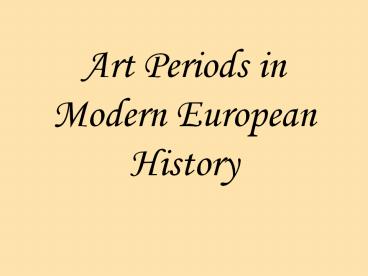Art Periods in Modern European History - PowerPoint PPT Presentation
1 / 53
Title:
Art Periods in Modern European History
Description:
Art Periods in Modern European History Renaissance Based on rationality, admiration of classicism, a secular approach to the world. Innovations include oil paint, use ... – PowerPoint PPT presentation
Number of Views:917
Avg rating:3.0/5.0
Title: Art Periods in Modern European History
1
Art Periods in Modern European History
2
Renaissance
- Based on rationality, admiration of classicism, a
secular approach to the world. - Innovations include oil paint, use of point
perspective, shading, use of an outside source of
light.
3
(No Transcript)
4
(No Transcript)
5
(No Transcript)
6
Mannerism
- More subjective and emotional.
- Mannerism reflects the troubled time of the
reformation vs. Catholic counter reformation - Abandonment of perspective, or very elongated
exaggerated limbs, dark shadows. - El Greco, Titian, late Michelangelo.
7
(No Transcript)
8
(No Transcript)
9
Baroque
- More realistic than mannerism.
- Grand, elaborate, formal, and emotional.
- Tied to grandeur of the church or monarchs.
- Rubens, Velazquez, Bach, Handel, Opera, Milton,
late Shakespeare, Cervantes.
10
(No Transcript)
11
(No Transcript)
12
(No Transcript)
13
Rococo
- Elaborate but lighter, almost dainty.
- Mainly the 1700s.
- Watteau, Fragonard
- Great patron was Louis XVs mistress, Madame de
Pompadour.
14
(No Transcript)
15
(No Transcript)
16
(No Transcript)
17
Realism
- Netherlands
- Fans Hals, Jan Vermeer, Rembrandt.
- Still life, everyday scenes, spiritual side of
life reflected in faces.
18
(No Transcript)
19
(No Transcript)
20
(No Transcript)
21
Neoclassicism
- Late 1700s.
- Tied to the Enlightenment.
- Use of the arch, simple forms..
- Paintings Statuesque, simple, balanced, clear,
less emotion.
22
(No Transcript)
23
(No Transcript)
24
Romanticism
- Objections to the Enlightenments emphasis on
reason, form, and the classics. - Themes of nature, simple life.
- Gothic images or exotic images.
- Music ballads, folk songs
- Writers Keats, Shelley, Lord Byron.
25
(No Transcript)
26
(No Transcript)
27
(No Transcript)
28
(No Transcript)
29
(No Transcript)
30
(No Transcript)
31
Realism
- Romanticism considered too sentimental.
- Later 1800s.
- Art intended to push for social reform realistic
depiction of life and its problems. - Gustave, Courbet, Daumier, Millet.
- Literature Balzac, Flaubert, Dickens.
32
(No Transcript)
33
(No Transcript)
34
Naturalism
- Mid 18th century literary movement.
- Scientific description of nature and the mind.
- Zola, Stephen Crane, Ibsen.
35
Symbolism
- Literary movement that suggested rather than
named. - Mallamè
36
Impressionism
- Pleasant scenes rather than social comment,
abandon line, perspective, and studio light. - Attempt to capture a fleeting moment in time.
- Monet, Degas, Renoir.
37
(No Transcript)
38
(No Transcript)
39
Post-Impressionism
- Turning away from impressionism because it lacked
form and discipline. - This movement was only united in rejecting
impressionism. - Expressed chaos and complexity of the machine
age. - Importance of line.
- Beginnings of the modern art movement.
- Cezanne, Seurat, Gaugin, Van Gogh,
Toulouse-Latrec.
40
(No Transcript)
41
(No Transcript)
42
(No Transcript)
43
Cubism
- Use of shape to suggest reality.
- Movement toward abstraction.
- Picasso, Braque.
44
(No Transcript)
45
(No Transcript)
46
(No Transcript)
47
Expressionism
- Use of strong color and line to show emotion and
lack of order in the human mind. - Influence of African masks and images (and
influence of Imperialism) - Matisse, Munch, Van Gogh.
48
(No Transcript)
49
Abstract expressionism
- Purely abstract, emotionally associative design
of shapes and colors. - Kandinsky, New York school.
- Reflection of modern timespost World War I
50
(No Transcript)
51
Surrealism
- Psychological paintings, sometimes very
realistic, that reveal the inner mind. - Dali, Klee, Miro, Chagall.
- Again, reflection of Freudian concepts and the
scars that World War I and II have on the world
psyche.
52
(No Transcript)
53
(No Transcript)































